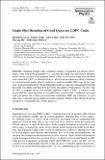| dc.contributor.author | Gu, Shouzhen | |
| dc.contributor.author | Tang, Eugene | |
| dc.contributor.author | Caha, Libor | |
| dc.contributor.author | Choe, Shin Ho | |
| dc.contributor.author | He, Zhiyang | |
| dc.contributor.author | Kubica, Aleksander | |
| dc.date.accessioned | 2024-03-18T15:28:40Z | |
| dc.date.available | 2024-03-18T15:28:40Z | |
| dc.date.issued | 2024-03 | |
| dc.identifier.issn | 0010-3616 | |
| dc.identifier.issn | 1432-0916 | |
| dc.identifier.uri | https://hdl.handle.net/1721.1/153814 | |
| dc.description.abstract | Quantum Tanner codes constitute a family of quantum low-density parity-check codes with good parameters, i.e., constant encoding rate and relative distance. In this article, we prove that quantum Tanner codes also facilitate single-shot quantum error correction (QEC) of adversarial noise, where one measurement round (consisting of constant-weight parity checks) suffices to perform reliable QEC even in the presence of measurement errors. We establish this result for both the sequential and parallel decoding algorithms introduced by Leverrier and Zémor. Furthermore, we show that in order to suppress errors over multiple repeated rounds of QEC, it suffices to run the parallel decoding algorithm for constant time in each round. Combined with good code parameters, the resulting constant-time overhead of QEC and robustness to (possibly time-correlated) adversarial noise make quantum Tanner codes alluring from the perspective of quantum fault-tolerant protocols. | en_US |
| dc.publisher | Springer Science and Business Media LLC | en_US |
| dc.relation.isversionof | 10.1007/s00220-024-04951-6 | en_US |
| dc.rights | Creative Commons Attribution | en_US |
| dc.rights.uri | https://creativecommons.org/licenses/by/4.0/ | en_US |
| dc.source | Springer Berlin Heidelberg | en_US |
| dc.subject | Mathematical Physics | en_US |
| dc.subject | Statistical and Nonlinear Physics | en_US |
| dc.title | Single-Shot Decoding of Good Quantum LDPC Codes | en_US |
| dc.type | Article | en_US |
| dc.identifier.citation | Communications in Mathematical Physics. 2024 Mar 14;405(3):85 | en_US |
| dc.contributor.department | Massachusetts Institute of Technology. Center for Theoretical Physics | |
| dc.contributor.department | Massachusetts Institute of Technology. Department of Physics | |
| dc.contributor.department | Massachusetts Institute of Technology. Department of Mathematics | |
| dc.identifier.mitlicense | PUBLISHER_CC | |
| dc.eprint.version | Final published version | en_US |
| dc.type.uri | http://purl.org/eprint/type/JournalArticle | en_US |
| eprint.status | http://purl.org/eprint/status/PeerReviewed | en_US |
| dc.date.updated | 2024-03-17T04:13:10Z | |
| dc.language.rfc3066 | en | |
| dc.rights.holder | The Author(s) | |
| dspace.embargo.terms | N | |
| dspace.date.submission | 2024-03-17T04:13:09Z | |
| mit.journal.volume | 405 | en_US |
| mit.journal.issue | 3 | en_US |
| mit.license | PUBLISHER_CC | |
| mit.metadata.status | Authority Work and Publication Information Needed | en_US |
